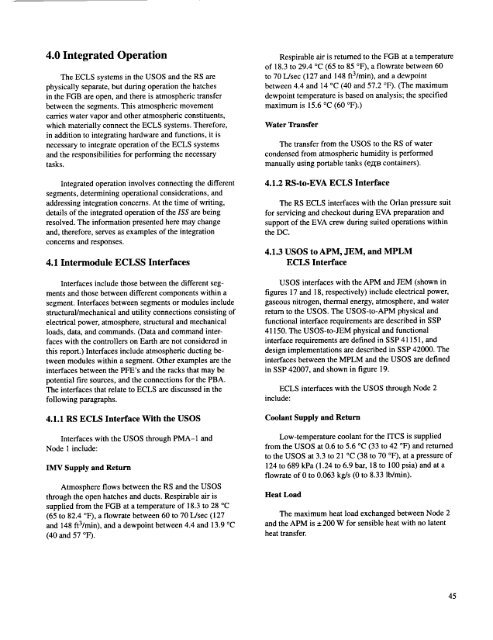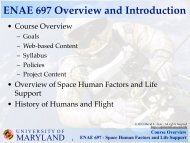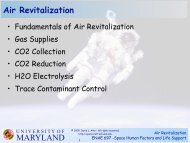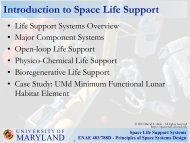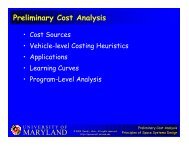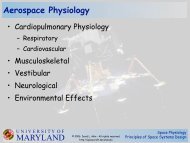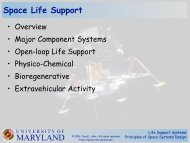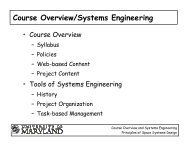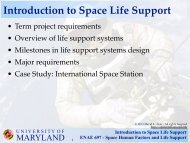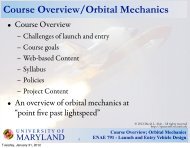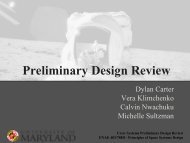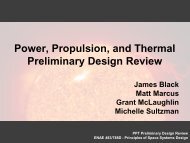Living Together in Space: The Design and Operation of the Life ...
Living Together in Space: The Design and Operation of the Life ...
Living Together in Space: The Design and Operation of the Life ...
Create successful ePaper yourself
Turn your PDF publications into a flip-book with our unique Google optimized e-Paper software.
4.0 Integrated <strong>Operation</strong><br />
<strong>The</strong> ECLS systems <strong>in</strong> <strong>the</strong> USOS <strong>and</strong> <strong>the</strong> RS are<br />
physically separate, but dur<strong>in</strong>g operation <strong>the</strong> hatches<br />
<strong>in</strong> <strong>the</strong> FGB are open, <strong>and</strong> <strong>the</strong>re is atmospheric transfer<br />
between <strong>the</strong> segments. This atmospheric movement<br />
carries water vapor <strong>and</strong> o<strong>the</strong>r atmospheric constituents,<br />
which materially connect <strong>the</strong> ECLS systems. <strong>The</strong>refore,<br />
<strong>in</strong> addition to <strong>in</strong>tegrat<strong>in</strong>g hardware <strong>and</strong> functions, it is<br />
necessary to <strong>in</strong>tegrate operation <strong>of</strong> <strong>the</strong> ECLS systems<br />
<strong>and</strong> <strong>the</strong> responsibilities for perform<strong>in</strong>g <strong>the</strong> necessary<br />
tasks.<br />
Integrated operation <strong>in</strong>volves connect<strong>in</strong>g <strong>the</strong> different<br />
segments, determ<strong>in</strong><strong>in</strong>g operational considerations, <strong>and</strong><br />
address<strong>in</strong>g <strong>in</strong>tegration concerns. At <strong>the</strong> time <strong>of</strong> writ<strong>in</strong>g,<br />
details <strong>of</strong> <strong>the</strong> <strong>in</strong>tegrated operation <strong>of</strong> <strong>the</strong> ISS are be<strong>in</strong>g<br />
resolved. <strong>The</strong> <strong>in</strong>formation presented here may change<br />
<strong>and</strong>, <strong>the</strong>refore, serves as examples <strong>of</strong> <strong>the</strong> <strong>in</strong>tegration<br />
concerns <strong>and</strong> responses.<br />
4.1 Intermodule ECLSS Interfaces<br />
Interfaces <strong>in</strong>clude those between <strong>the</strong> different seg-<br />
ments <strong>and</strong> those between different components with<strong>in</strong> a<br />
segment. Interfaces between segments or modules <strong>in</strong>clude<br />
structural/mechanical <strong>and</strong> utility connections consist<strong>in</strong>g <strong>of</strong><br />
electrical power, atmosphere, structural <strong>and</strong> mechanical<br />
loads, data, <strong>and</strong> comm<strong>and</strong>s. (Data <strong>and</strong> comm<strong>and</strong> <strong>in</strong>terfaces<br />
with <strong>the</strong> controllers on Earth are not considered <strong>in</strong><br />
this report.) Interfaces <strong>in</strong>clude atmospheric duct<strong>in</strong>g be-<br />
tween modules with<strong>in</strong> a segment. O<strong>the</strong>r examples are <strong>the</strong><br />
<strong>in</strong>terfaces between <strong>the</strong> PFE's <strong>and</strong> <strong>the</strong> racks that may be<br />
potential fire sources, <strong>and</strong> <strong>the</strong> connections for <strong>the</strong> PBA.<br />
<strong>The</strong> <strong>in</strong>terfaces that relate to ECLS are discussed <strong>in</strong> <strong>the</strong><br />
follow<strong>in</strong>g paragraphs.<br />
4.1.1 RS ECLS Interface With <strong>the</strong> USOS<br />
Interfaces with <strong>the</strong> USOS through PMA-1 <strong>and</strong><br />
Node 1 <strong>in</strong>clude:<br />
IMV Supply <strong>and</strong> Return<br />
Atmosphere flows between <strong>the</strong> RS <strong>and</strong> <strong>the</strong> USOS<br />
through <strong>the</strong> open hatches <strong>and</strong> ducts. Respirable air is<br />
supplied from <strong>the</strong> FGB at a temperature <strong>of</strong> 18.3 to 28 °C<br />
(65 to 82.4 °F), a flowrate between 60 to 70 L/sec (127<br />
<strong>and</strong> 148 ft3/m<strong>in</strong>), <strong>and</strong> a dewpo<strong>in</strong>t between 4.4 <strong>and</strong> 13.9 °C<br />
(40 <strong>and</strong> 57 oF).<br />
Respirable air is returned to <strong>the</strong> FGB at a temperature<br />
<strong>of</strong> 18.3 to 29.4 °C (65 to 85 oF), a flowrate between 60<br />
to 70 L/sec (127 <strong>and</strong> 148 ft3/m<strong>in</strong>), <strong>and</strong> a dewpo<strong>in</strong>t<br />
between 4.4 <strong>and</strong> 14 °C (40 <strong>and</strong> 57.2 °F). (<strong>The</strong> maximum<br />
dewpo<strong>in</strong>t temperature is based on analysis; <strong>the</strong> specified<br />
maximum is 15.6 °C (60 °F).)<br />
Water Transfer<br />
<strong>The</strong> transfer from <strong>the</strong> USOS to <strong>the</strong> RS <strong>of</strong> water<br />
condensed from atmospheric humidity is performed<br />
manually us<strong>in</strong>g portable tanks (e_s conta<strong>in</strong>ers).<br />
4.1.2 RS-to-EVA ECLS Interface<br />
<strong>The</strong> RS ECLS <strong>in</strong>terfaces with <strong>the</strong> Orlan pressure suit<br />
for servic<strong>in</strong>g <strong>and</strong> checkout dur<strong>in</strong>g EVA preparation <strong>and</strong><br />
support <strong>of</strong> <strong>the</strong> EVA crew dur<strong>in</strong>g suited operations with<strong>in</strong><br />
<strong>the</strong> DC.<br />
4.1.3 USOS to APM, JEM, <strong>and</strong> MPLM<br />
ECLS Interface<br />
USOS <strong>in</strong>terfaces with <strong>the</strong> APM <strong>and</strong> JEM (shown <strong>in</strong><br />
figures 17 <strong>and</strong> 18, respectively) <strong>in</strong>clude electrical power,<br />
gaseous nitrogen, <strong>the</strong>rmal energy, atmosphere, <strong>and</strong> water<br />
return to <strong>the</strong> USOS. <strong>The</strong> USOS-to-APM physical <strong>and</strong><br />
functional <strong>in</strong>terface requirements are described <strong>in</strong> SSP<br />
41150. <strong>The</strong> USOS-to-JEM physical <strong>and</strong> functional<br />
<strong>in</strong>terface requirements are def<strong>in</strong>ed <strong>in</strong> SSP 41151, <strong>and</strong><br />
design implementations are described <strong>in</strong> SSP 42000. <strong>The</strong><br />
<strong>in</strong>terfaces between <strong>the</strong> MPLM <strong>and</strong> <strong>the</strong> USOS are def<strong>in</strong>ed<br />
<strong>in</strong> SSP 42007, <strong>and</strong> shown <strong>in</strong> figure 19.<br />
ECLS <strong>in</strong>terfaces with <strong>the</strong> USOS through Node 2<br />
<strong>in</strong>clude:<br />
Coolant Supply <strong>and</strong> Return<br />
Low-temperature coolant for <strong>the</strong> ITCS is supplied<br />
from <strong>the</strong> USOS at 0.6 to 5.6 °C (33 to 42 oF) <strong>and</strong> returned<br />
to <strong>the</strong> USOS at 3.3 to 21 °C (38 to 70 °F), at a pressure <strong>of</strong><br />
124 to 689 kPa (1.24 to 6.9 bar, 18 to 100 psia) <strong>and</strong> at a<br />
flowrate <strong>of</strong> 0 to 0.063 kg/s (0 to 8.33 lb/m<strong>in</strong>).<br />
Heat Load<br />
<strong>The</strong> maximum heat load exchanged between Node 2<br />
<strong>and</strong> <strong>the</strong> APM is _+200 W for sensible heat with no latent<br />
heat transfer.<br />
45


